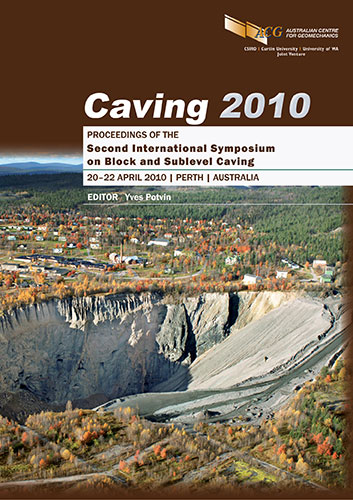Microseismic tools for the analysis of the interaction between open pit and underground developments

|
Authors: Reyes-Montes, JM; Sainsbury, BL; Pettitt, WS; Pierce, M; Young, RP |
DOI https://doi.org/10.36487/ACG_rep/1002_5_Reyes-Montes
Cite As:
Reyes-Montes, JM, Sainsbury, BL, Pettitt, WS, Pierce, M & Young, RP 2010, 'Microseismic tools for the analysis of the interaction between open pit and underground developments', in Y Potvin (ed.), Caving 2010: Proceedings of the Second International Symposium on Block and Sublevel Caving, Australian Centre for Geomechanics, Perth, pp. 119-131, https://doi.org/10.36487/ACG_rep/1002_5_Reyes-Montes
Abstract:
The transition from surface to underground mining presents a series of technical and operational challenges, in particular those arising from the interaction between the cave and the overlying pit. Seismic monitoring provides a unique means to obtain near real-time information about the development of the fracturing process induced by the mining operations. This paper presents the analysis of temporal, spatial and source size patterns in the seismicity recorded during undercutting and production at the Palabora Mine leading to slope failure in the open pit above, and relates these results to full-scale analysis of the rock mass behaviour in three-dimensional numerical models. Based on the application of the techniques described herein, it is shown that the back analysis of the seismic data provides a prediction technique that could now be employed during the planning stages of a mining operation. It is hoped that by employing these new techniques it would be possible to incorporate results from predicted fracture network behaviour into engineering designs in similar future mining operations and thus provide a means to predict and mitigate against large scale failure as observed at the Palabora Mine.
References:
Diederichs, M.S. (2000) Instability of Hard Rockmasses: The Role of Tensile Damage and Relaxation, PhD Thesis, University of Waterloo, 617 p.
Falmagne, V. (2002) Quantification of rock mass degradation using microseismic monitoring and applications for mine design, PhD thesis, Queen’s University, Kingston, Canada.
Gibowicz, S.J. and Kijko, A. (1994) An introduction to mining seismology, Academic Press.
Glazer, S.N. (2002–2006) Monthly Seismic Monitoring Reports, July 2002 to June 2006, Reports to Palabora Mining Company Limited.
Glazer, S.N. and Hepworth, N. (2003) Seismicity Induced by Cave Mining at Palabora Mining Company, Version 1.0, March 2003.
Glazer, S.N. and Hepworth, N. (2006) Crown pillar failure mechanism – case study based on seismic data from Palabora Mine, Mining Technology, Vol. 115, No. 2, pp. 75–84.
Hanks, T.C. and Wyss, N. (1972) Use of Body-Wave Spectra in Determination of Seismic - Source Parameters, Bulletin of the Seismological Society of America, Vol. 62(2), pp. 561–589.
Lockner, D.A., Moore, D.E. and Reches, Z. (1992) Microcrack interaction leading to shear fracture, in Proceedings 33rd U.S. Symposium on Rock Mechanics, J.R. Tillerson and W.R. Wawersik (eds), A.A. Balkema, Rotterdam, pp. 807–816.
Madariaga, R. (1976) Dynamics of an expanding circular fault, Bulletin of the Seismological Society of America,
Vol. 66, No. 3, pp. 639–666.
Mas Ivars, D., Pierce, M., DeGagné, D. and Darcel, C. (2008) Anisotropy and scale dependency in jointed rock mass strength – A synthetic rock mass study, in Proceedings First International FLAC/DEM Symposium on Numerical Modelling (Continuum and Distinct Element Numerical Modeling in Geo-Engineering), R. Hart,
C. Detournay and P. Cundall (eds), 25–27 August 2008, Minneapolis, USA, Minneapolis: Itasca, Paper
No. 06-01.
Pettitt, W.S. and Young, R.P. (2007) InSite Seismic Processor, Technical Appendices to the Users Manual, Shrewsbury, UK, Applied Seismology Consultants Ltd.
Pierce, M., Cundall, P., Potyondy, D. and Mas Ivars, D. (2007) A Synthetic Rock Mass Model for Jointed Rock, in Rock Mechanics: Meeting Society’s Challenges and Demands (1st Canada-U.S. Rock Mechanics Symposium), Vancouver, May 2007, E. Eberhardt, D. Stead and T. Morrison (eds), Taylor and Francis Group, London, Vol. 1: Fundamentals, New Technologies and New Ideas, pp. 341–349.
Reches, Z. and Lockner, D.A. (1994) Nucleation and Growth of Faults in Brittle Rocks, Journal of Geophysical Research-Solid Earth, Vol. 99(B9), pp. 18159–18173.
Reyes-Montes, J.M. and Young, R.P. (2006) Interpretation of fracture geometry from excavation induced microseismic events, in Proceedings International Symposium of the International Society for Rock Mechanics, Eurock 2006, 9–12 May 2006, Liege, Belgium.
Reyes-Montes, J.M., Pettitt, W.S., Haycox, J.R., Hemmings, B. and Young, R.P. (2009) Microseismic analysis for the quantification of crack interaction during hydraulic stimulation, SEG International Exposition and 79th Annual Meeting, 25–30 October 2009, Houston, Texas, USA.
Sainsbury, B., Pierce, M. and Mas Ivars, D. (2008) Analysis of Caving Behaviour Using a Synthetic Rock Mass —Ubiquitous Joint Rock Mass Modelling Technique, in Proceedings 1st Southern Hemisphere International Rock Mechanics Symposium (SHIRMS), Y. Potvin, J. Carter, A. Dyskin and R. Jeffrey (eds), 16–19 September 2009, Perth, Australia, Australian Centre for Geomechanics, Vol. 1 – Mining and Civil, pp. 243–253.
Young, R.P., Collins, D.S., Hazzard, J., Reyes-Montes, J.M. and Baker, C. (2007) Quantifying and Interpreting Microseismicity, In Challenges in Deep and High Stress Mining, Y. Potvin, J. Hadjigeorgiou and D. Stacey (eds), Australian Centre for Geomechanics, Perth, pp. 469–476.
© Copyright 2025, Australian Centre for Geomechanics (ACG), The University of Western Australia. All rights reserved.
View copyright/legal information
Please direct any queries or error reports to repository-acg@uwa.edu.au
View copyright/legal information
Please direct any queries or error reports to repository-acg@uwa.edu.au